What is Customer Lifetime Value?

Heading 1
Heading 2
Heading 3
Heading 4
Heading 5
Heading 6
Lorem ipsum dolor sit amet, consectetur adipiscing elit, sed do eiusmod tempor incididunt ut labore et dolore magna aliqua. Ut enim ad minim veniam, quis nostrud exercitation ullamco laboris nisi ut aliquip ex ea commodo consequat. Duis aute irure dolor in reprehenderit in voluptate velit esse cillum dolore eu fugiat nulla pariatur.
Block quote
Ordered list
- Item 1
- Item 2
- Item 3
Unordered list
- Item A
- Item B
- Item C
Bold text
Emphasis
Superscript
Subscript
What is Customer Lifetime Value?
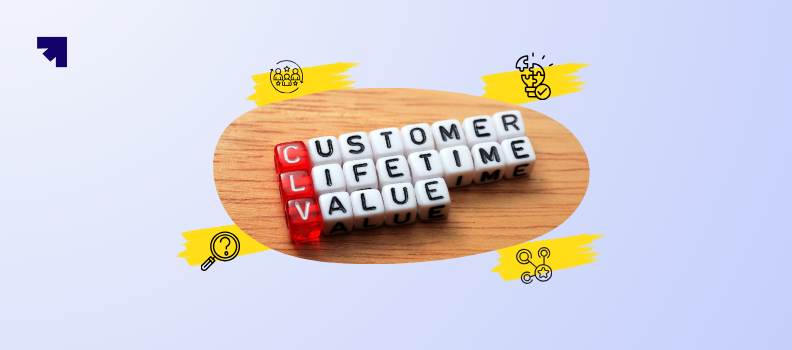
N.Suresh
Join us on November 6th as Mr. Yash Mishra, Product Manager, Fatakpay, reveals the precise strategies that eliminates the speed trap and guarantees a 30% conversion boost.
Customer acquisition costs are climbing every single day, and many companies end up spending more to win a customer than they’ll ever earn back from them. With rising ad prices, shrinking attention spans, and cutthroat competition, customer lifetime value (CLV or LTV) has become the line between vanity growth and real profitability.
The businesses that last understand the true economic value of every customer they bring in. For founders and executives, it’s the number that determines how budgets are allocated. For marketers and growth teams, it dictates how campaigns are optimized. For analysts and finance teams, it’s the anchor for forecasting and ROI models. And for SaaS or e-commerce businesses, it often decides whether you scale sustainably or burn out too soon.
Understanding the customer lifetime value, knowing how to calculate it, and applying strategies to increase it can completely shift the way you grow. Done right, CLV becomes less of a metric and more of a growth compass for the entire business.
What is Customer Lifetime Value (CLV/LTV)?
Definition of Customer Lifetime Value (CLV or LTV): Customer Lifetime Value is the total revenue a business can reasonably expect to earn from a single customer throughout their entire relationship. This metric answers how much a customer is worth to your business over time.
You’ll often see CLV and LTV used interchangeably. Strictly speaking, some practitioners draw a small distinction.
- CLV is sometimes used to describe the value of an individual customer
- LTV is often used to represent the average value across your customer base
But in practice, both terms point to the same principle of understanding the long-term economic contribution of your customers.
Components of CLV
CLV isn’t a single number pulled out of thin air. It’s built from several measurable factors working together:
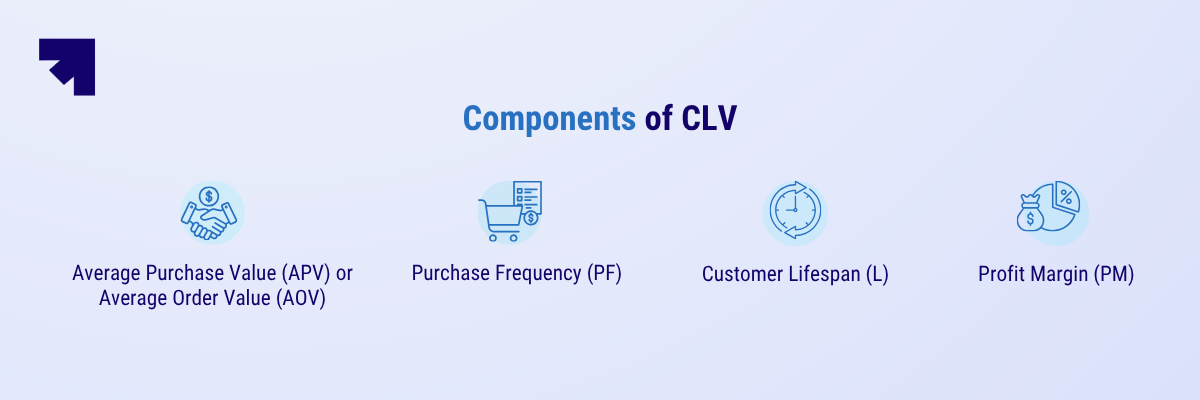
- Average Purchase Value (APV) or Average Order Value (AOV): The revenue you make per transaction.
- Purchase Frequency (PF): How often a customer buys in a set period (monthly, annually, etc.)
- Customer Lifespan (L): The average length of time a customer continues buying before churning
- Profit Margin (PM): Whether you’re calculating CLV based on revenue or on net profit contribution
Types of Customer Lifetime Value (CLV)
Not all CLV calculations are created equal. Some focus on what customers have already spent, others forecast what they might spend in the future, and some highlight specific groups to understand patterns more clearly.
- Historical or Retrospective CLV: This is the simplest approach; it looks purely at past transactions. How much has a customer spent with you so far? It’s useful for understanding trends.
- Predictive CLV: This one is forward-looking. By analyzing behavioral data, using statistical models, or leveraging machine learning, predictive CLV estimates a customer’s future value. SaaS, e-commerce, and subscription businesses rely heavily on this because customer retention drives long-term profitability.
- Segment-Based CLV: Instead of lumping all customers together, segment-based CLV breaks them into cohorts by acquisition channel, region, product line, or other meaningful categories. This helps you see which segments bring the most sustainable value, so your strategies can be more targeted and effective.
Why is Customer Lifetime Value Important?
The following points explain the importance of the metric.
1. For Marketing and Return On Investment
Every dollar you spend on acquiring a customer only makes sense if you know how much that customer is worth. Your CLV: CAC ratio (Customer Lifetime Value vs Customer Acquisition Cost) shows whether your acquisition spend is profitable or just feeding vanity metrics. It guides ad bids, marketing budgets, and tells you whether growth is real or artificially inflated.
2. For Retention and Churn Reduction
By tracking declining engagement, reduced purchase frequency, or shorter lifespans, companies can spot early warning signs of churn. Teams can then step in with personalized campaigns, loyalty programs, or proactive outreach to extend relationships and reduce churn rate to increase revenue.
3. For Product Strategy and Customer Experience
The longer customers stay, the more they reveal about your product or service. CLV highlights the link between user experience and revenue. Smooth onboarding, responsive support, and feedback loops all raise CLV. Friction and poor experiences shorten lifespans and shrink profits. It’s why CLV should be a north-star metric not only for marketing, but also for product and CX leaders.
4. For Business Forecasting and Financial Planning
Revenue today is important, but investors and leadership care about tomorrow. High CLV makes forecasts more predictable and credible. Finance teams can model budgets, plan cash flow, and calculate ROI over multiple years. For startups, a strong CLV: CAC story signals scalable growth without burning through capital.
5. For Segmentation and Personalization
Not all customers are equal, and CLV shows you who matters most. By analyzing cohorts, businesses can give high-value customers premium perks, early access, or concierge support, while lower-value segments are engaged with scaled or automated campaigns. This ensures resources go where they actually move the needle.
CLV vs NPS vs CSAT: A Comparison
Metrics are powerful, but they each tell a different story. Understanding the difference helps you see the full picture.
- Customer Lifetime Value (CLV): The total revenue a business can expect from a single customer over the entire duration of their relationship. It answers, “How much are our customers worth to the business over time?”
- Net Promoter Score (NPS): A metric that measures customer loyalty by asking how likely customers are to recommend your brand to others. It answers, “How emotionally connected are our customers, and how likely are they to promote us?”
- Customer Satisfaction Score (CSAT): A short-term measure of customer happiness, typically captured right after an interaction or purchase. It answers, “Did we meet customer expectations in this specific interaction?”
Here’s the key: NPS and CSAT show how customers feel. CLV shows what those feelings are worth in real dollars. Together, they give a full picture of customer health and business value.
| Metric | Focus | Time Horizon | Owner | Business Impact |
|---|---|---|---|---|
| CLV (Customer Lifetime Value) | Total economic value of a customer | Long-term | Finance, Growth, Leadership | Guides budgets, strategy, and profitability |
| NPS (Net Promoter Score) | Likelihood of recommending the brand | Medium to long-term | Marketing, CX | Predicts loyalty, advocacy, and referral growth |
| CSAT (Customer Satisfaction) | Satisfaction with a single interaction | Short-term | Support, Operations | Identifies service gaps, improves touchpoints |
A high CSAT without a high CLV may mean customers like you, but don’t buy enough. A strong CLV with a weak NPS may mean customers are profitable but not loyal, leaving you exposed to churn if competitors show up.
Smart companies don’t choose between them. They use CLV as the anchor metric for financial value, with NPS and CSAT as leading indicators that help explain why CLV is rising or falling.
How to Calculate Customer Lifetime Value (CLV)
Customer lifetime value is just revenue per customer, multiplied by how long they stay with you. But the way you calculate it depends on how precise you want to be.
The Basic CLV Formula is :
CLV = Average Purchase Value × Purchase Frequency × Customer Lifespan
Average Purchase Value = Total revenue ÷ Number of purchases
Purchase Frequency = Number of purchases ÷ Number of customers
Customer Lifespan = Average time a customer continues buying from you
This version is quick, directional, and works well for high-level analysis. If you want a more accurate measure, replace revenue with profit margin:
CLV = (Average Purchase Value × Purchase Frequency × Customer Lifespan) × Profit Margin
This gives a true sense of value, not just sales volume.
For example, in a SaaS company,
Average revenue per user (ARPU) = $40/month
Average lifespan = 24 months
Gross margin = 70%
CLV = $40 × 24 × 0.7 = $672 (per customer)
For more advanced businesses, predictive CLV uses historical purchase behavior, churn probabilities, and machine learning models to forecast future value. This is especially powerful in SaaS and subscription businesses, where retention and churn data are readily available.
Factors That Influence CLV

Customer Lifetime Value (CLV) shifts based on how customers behave and how businesses respond. Here are the biggest levers that impact CLV:
- Purchase frequency: More repeat purchases mean higher lifetime value. Subscription models thrive because they lock in a predictable frequency.
- Average order value (AOV): Bundles, upsells, and premium options raise the spend per transaction, amplifying CLV without needing more customers.
- Customer retention/churn Rate/lifespan: Even a small increase in retention dramatically lifts CLV. Conversely, high churn cuts lifetime value short.
- Customer experience and onboarding: A smooth first experience often decides whether customers stick or leave early, setting the tone for long-term value.
- Customer support/satisfaction (NPS & CSAT): Every interaction can either strengthen loyalty or drive attrition. Great support boosts trust and CLV.
- Upselling and cross-selling: Offering relevant add-ons or higher tiers increases revenue per customer without new acquisition costs.
- Brand trust and community: When customers feel part of a brand’s mission or community, they stay longer, spend more, and advocate more.
- External factors such as competition, price sensitivity, and economy: Market conditions can compress or expand CLV. Strong differentiation helps cushion against external shocks.
Examples of CLV for Different Businesses
CLV looks very different depending on whether you’re running a SaaS product, a retail store, or a B2B service. Let’s break it down by context.
1. SaaS / Subscription Businesses
In SaaS, CLV is the heartbeat of the business model. Key drivers are monthly recurring revenue (MRR), churn rate, and ARPU (average revenue per user).
Example: A SaaS customer paying $50/month with an average lifespan of 24 months has a CLV of $1,200 before factoring in margins. Netflix is a classic case of small monthly payments, but extremely high CLV because subscribers stick around for years.
For SaaS, CLV is the difference between scaling sustainably and running out of runway.
2. E-commerce / Retail
For online and offline retail, CLV is shaped by repeat purchases and average basket size.
Example: A customer with an average order value of $80, buying 4 times a year, and staying active for 3 years = CLV of $960. Amazon Prime is a benchmark here; members shop more frequently and spend significantly more, driving CLV far above non-Prime customers.
In e-commerce, CLV depends less on one big sale and more on nudging customers to come back consistently.
3. Physical Products or Services (Non-Subscription)
Think gyms, salons, or automotive services, where visits are periodic, not automatic. A gym member paying $40/month but only staying for 10 months has a CLV of $400. Peloton shows how this can evolve into a one-time purchase model; they expanded into subscriptions to extend CLV.
Non-subscription services rely heavily on customer satisfaction and relationship building to extend lifespan.
B2B vs. B2C Differences
The nature of CLV shifts dramatically depending on whether you’re selling to businesses or consumers.
B2B CLV: Often much higher due to longer contracts, higher ticket sizes, and stickier relationships. Example: A $1,000/month SaaS contract lasting 3 years = $36,000 CLV.
B2C CLV: Usually lower per customer, but scales through volume. Example: Starbucks has mastered the $5 coffee multiplied daily over the years, turning casual buyers into high-CLV loyalists.
B2B focuses on depth with fewer but high-value customers. B2C focuses on breadth with many smaller customers.
Regional / Country Differences
Geography shapes spending patterns, loyalty, and customer lifespan.
- In mature markets (US, Western Europe), CLV tends to be higher because of stronger purchasing power and longer customer relationships. Apple, for instance, thrives in these regions where customers stay in the ecosystem for years.
- In emerging markets, CLV may be smaller per customer, but the sheer size of the customer base can offset the difference. Jio in India demonstrates this with lower ARPU, but massive scale.
Strategies to Improve Customer Lifetime Value (CLV)
CLV doesn’t grow from customer acquisition alone. It grows when customers stay longer, spend more, and deepen their relationship with your brand. The strategies below combine proven industry practices with unique approaches that leading businesses use to maximize lifetime value.
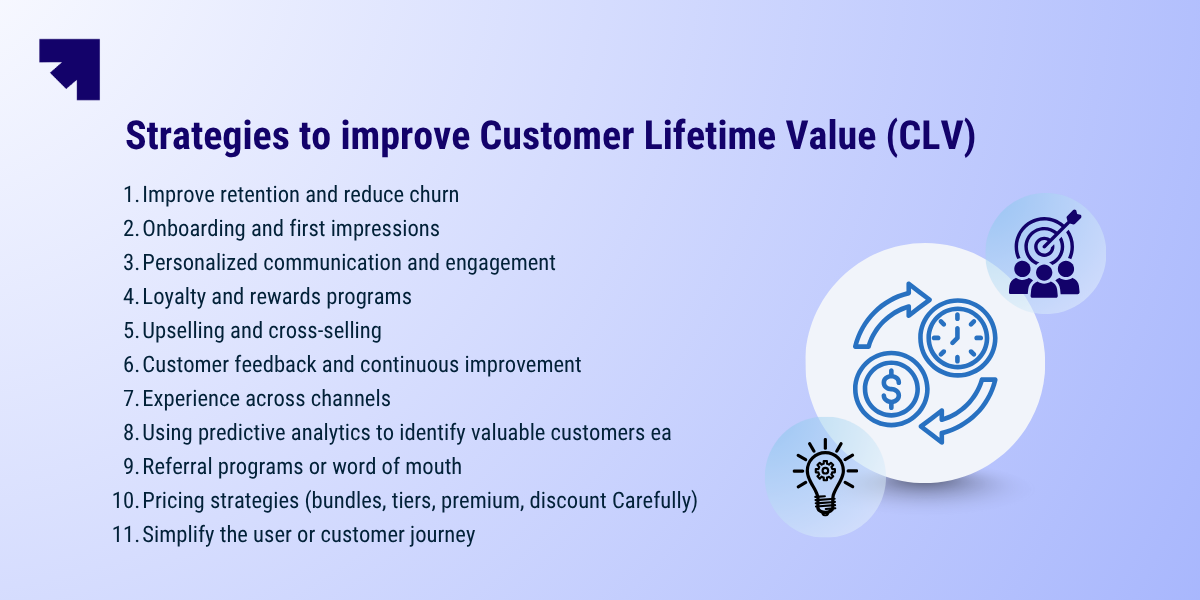
1. Improve retention and reduce churn: Keeping customers costs less than finding new ones. Even a 5% increase in retention can boost profits by 25 - 95%. Proactive support, churn prediction models, and attentive customer success teams are essential.
Example: Spotify tracks churn signals, such as skipped logins or dropped playlists, and uses re-engagement emails to win customers back before they leave.
2. Onboarding and first impressions: The first 30 days often determine the next three years of a customer relationship. Frictionless onboarding, like welcome emails for e-commerce or product walkthroughs for SaaS, sets the tone for long-term engagement.
3. Personalized communication and engagement: One-size-fits-all messaging accelerates churn. Tailoring offers, reminders, and product recommendations based on behavior makes interactions feel relevant and sticky.
Example: Amazon’s “because you bought X” suggestions and Spotify’s curated playlists subtly encourage more engagement and repeat purchases.
4. Loyalty and rewards programs: Rewarding repeat behavior creates a habit loop. Points, tiers, and exclusive perks keep customers motivated to stay.
Example: Starbucks Rewards turns $5 coffee into thousands in lifetime spend by gamifying loyalty.
5. Upselling and cross-selling: Relevant upsells and cross-sells increase revenue without new acquisition costs. For SaaS, this often means moving customers to higher-value plans after they see success with a basic tier.
Example: Apple drives CLV by selling iPhones, then offering AirPods, iCloud storage, and AppleCare.
6. Customer feedback and continuous improvement: Listening actively to customers builds trust and loyalty. Surveys, NPS tracking, and feature-request loops signal that their voice shapes your product or service.
Example: Corefactors regularly integrates user feedback into updates, keeping customers engaged and satisfied.
7. Experience across channels: Customers don’t see channels, they see one brand. Delivering a seamless experience across web, mobile, in-store, and support builds trust and strengthens relationships.
8. Using predictive analytics to identify valuable customers early: Predictive models highlight which customers are likely to generate high CLV. Early identification allows targeted engagement and proactive retention efforts.
Example: Netflix uses viewing patterns to suggest content that keeps subscribers hooked. In retail, predictive analytics can flag VIP customers and offer exclusive incentives to prevent churn.
9. Referral programs or word of mouth: Satisfied customers become the most cost-effective acquisition channel. Incentivize referrals with credits, discounts, or special status perks.
10. Pricing strategies (bundles, tiers, premium, discount Carefully): Smart pricing directly impacts CLV. Tiered plans capture multiple segments, bundles increase average order value, and careful discounting maintains perceived value.
Example: Amazon Prime charges $139/year, a seemingly small amount, yet it drives enormous long-term loyalty and CLV.
11. Simplify the user or customer journey: Every extra click, barrier, or confusing step reduces lifetime value. Streamline checkout, improve search, and make customer support effortless.
Example: Shopify merchants optimizing checkout flows consistently see higher CLV.
Challenges and Limitations of CLV
While CLV is a powerful metric, it comes with inherent challenges that businesses must navigate:
- Data Issues: Incomplete, fragmented, or poorly tracked data can lead to inaccurate CLV estimates.
- Defining Lifetime in Non-Subscription Models: Estimating customer lifespan is straightforward in subscriptions but tricky for one-off purchases or irregular buying patterns.
- Averages Hide Variance: Using average CLV masks the wide differences between high-value and low-value customers.
- Predictive Model Assumptions: Forecasting CLV relies on assumptions that may not hold, introducing potential errors.
- Short-Term vs. Long-Term Trade-Offs: Focusing only on immediate revenue can conflict with strategies that maximize long-term CLV.
Benchmarks: What is a Good CLV / LTV Ratio?
Benchmarks vary widely depending on industry, business model, and customer behavior.
- SaaS: CLV varies by ARPU and churn; successful SaaS often aim for 12–18 months payback periods. Approximately $240,000 per customer, depending on plan pricing and contract length.
- E-commerce/ Retail: Ranges widely by industry, from <$100 for fast-moving goods to >$1,000 for luxury retail.
- Physical Products / Services (non-subscription): Typically between $200 and $1,000, influenced by purchase frequency and ticket size.
- B2B Enterprise: Often six-figure CLV per account due to long-term contracts and high transaction values.
Healthy CLV: CAC Ratio
- A widely accepted benchmark is 3:1, meaning for every $1 spent on customer acquisition, a business should generate $3 in customer lifetime value
- Ratios below 1:1 indicate that customer acquisition costs are higher than the revenue generated from customers, leading to unsustainable business practices.
- Ratios above 3:1 may suggest under-investment in customer acquisition efforts, potentially missing growth opportunities.
Tracking CLV Over Time
A “good” CLV isn’t static; it improves as retention rises, repeat purchases grow, and average order values increase. Segmenting by cohorts and monitoring trends helps identify which strategies are driving real gains.
Using CLV in Decision Making
CLV is a decision-making compass. Knowing the lifetime value of your customers helps businesses allocate resources, prioritize initiatives, and scale efficiently.
- Budgeting and marketing spend allocation: Invest in channels and campaigns that deliver the highest return based on predicted CLV.
- Acquisition vs. retention priority: High CLV customers justify higher acquisition spend, while low CLV segments may benefit more from retention efforts.
- Product development and feature prioritization: Features that improve retention, increase usage, or boost average order value have the greatest impact on CLV.
- Customer segmentation and targeting high-value segments: Focus marketing and support resources on segments with the most long-term value.
- Hiring, capacity planning, scaling: Use CLV insights to forecast growth needs and scale teams or infrastructure in line with profitable customer segments.
Start Treating CLV as Your Growth Compass
Your customers are your long-term assets. By tracking customer lifetime value meaningfully, you can make smarter acquisition bets, improve retention, and build stronger customer relationships.
Here’s what to do next:
- Audit your current CLV and CLV: CAC ratio to understand where you stand.
- Identify leaks in retention, onboarding, or customer support that reduce lifetime value.
- Use a CRM like Corefactors to measure, track, and improve CLV across the entire customer journey.
The businesses that win are not those who spend the most on acquisition but those who maximize the lifetime value of every customer they earn.
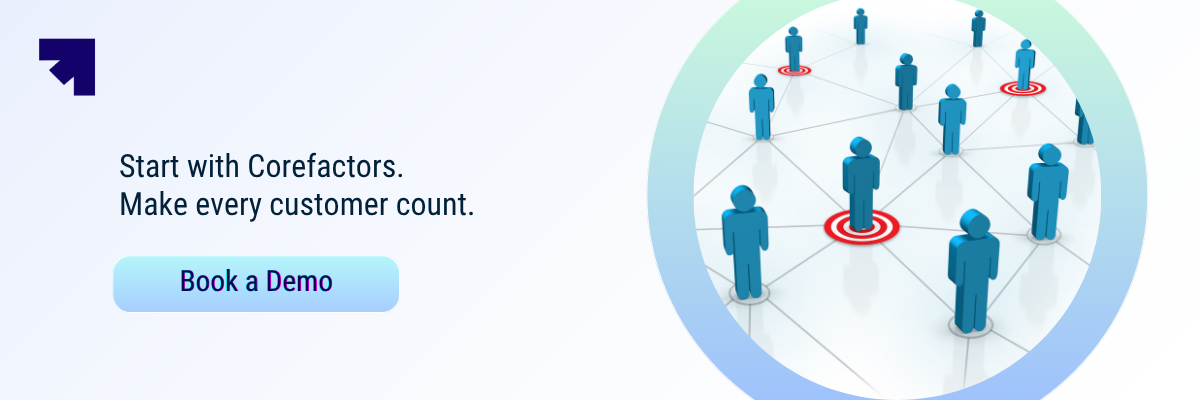
Heading 1
Heading 2
Heading 3
Heading 4
Heading 5
Heading 6
Lorem ipsum dolor sit amet, consectetur adipiscing elit, sed do eiusmod tempor incididunt ut labore et dolore magna aliqua. Ut enim ad minim veniam, quis nostrud exercitation ullamco laboris nisi ut aliquip ex ea commodo consequat. Duis aute irure dolor in reprehenderit in voluptate velit esse cillum dolore eu fugiat nulla pariatur.
Block quote
Ordered list
- Item 1
- Item 2
- Item 3
Unordered list
- Item A
- Item B
- Item C
Bold text
Emphasis
Superscript
Subscript
Frequently Asked Questions (FAQs)
1. What is Customer Lifetime Value (CLV)?


Customer Lifetime Value (CLV or LTV) measures the total revenue a customer is expected to generate throughout their relationship with your business. It helps companies make data-driven decisions on acquisition, retention, and marketing budgets.
2. What is the difference between CLV and LTV?


CLV and LTV are often used interchangeably, but LTV usually refers to a predictive value (future revenue), while CLV can include historical customer data. Both metrics focus on understanding a customer’s long-term worth.
3. Why is Customer Lifetime Value important for my business?


Understanding CLV helps you prioritize high-value customers, optimize marketing spend, reduce churn, and improve product or service offerings, ultimately increasing profitability.
4. How can I increase Customer Lifetime Value (CLV)?


You can increase CLV by improving retention, upselling and cross-selling, personalizing customer interactions, creating loyalty programs, and using predictive analytics to identify high-value customers early.







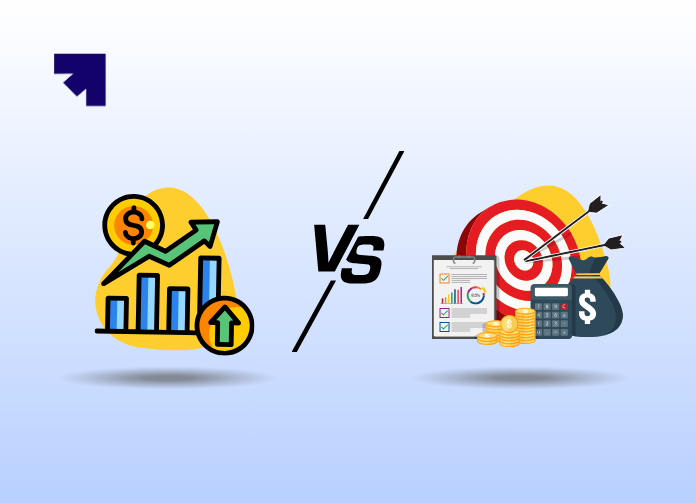
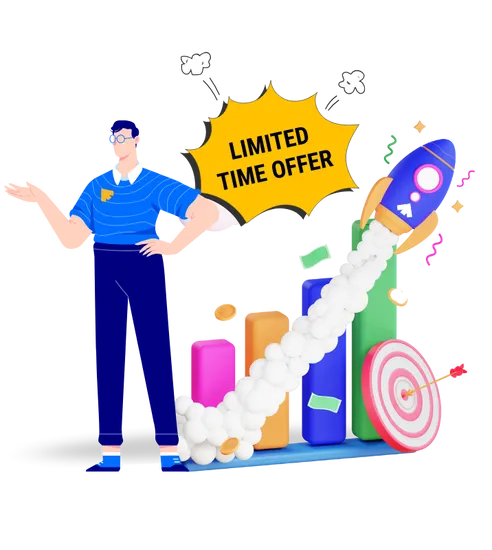











.png)




.png)